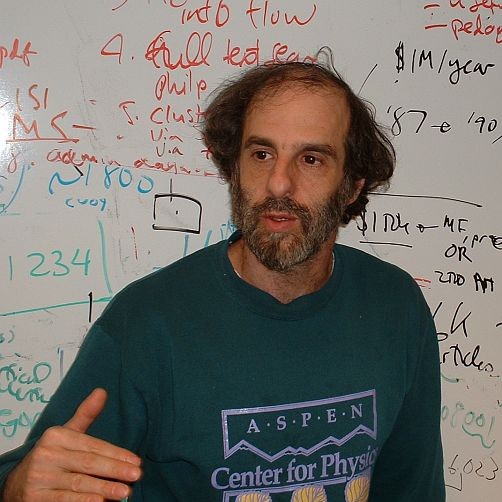Ron Vale (left), Jessica Polka (center), and Paul Ginsparg (right).
Ron Vale says he’s had a great run at science and now wants to focus on improving biomedical research for the next generation.
“I’ve had this magical life doing this work that I loved and now feel a moral obligation to make sure other young people can live that dream,” says the 58-year-old professor of cellular and molecular pharmacology at the University of California San Francisco.
Just how to attract and retain young scientists in the field is complicated, but Vale says one tangible way is to change the culture of how science is communicated and accelerate the process.
To address the issue, Vale wrote an opinion piece in biorXiv.org in July of 2015 in which he suggested that biologists consider using preprints to communicate their findings in parallel with using conventional journal publication. The idea of sharing preprints – drafts of scholarly articles posted online prior to publication in a peer-reviewed journal – attracted attention. Preprints are widely used in the physics, mathematics, and computer science communities, but were largely unknown and minimally used in biology in 2015.
Soon after, Vale worked with a small group of scientists including Harold Varmus, Jessica Polka and Daniel Colón-Ramos to further test the idea of whether preprints might have support in the life science community. The organizing committee’s grassroots efforts resulted in ASAPbio, an initiative to foster more widespread adoption of preprint usage in biology.
The Scholarly Publishing and Academic Resources Coalition honors ASAPbio with its January 2017 SPARC Innovator award for promoting the rapid advancement of biological science through the open sharing of research.
“It’s exciting to see this kind of movement emerging from the heart of the scientific community,” says Heather Joseph, executive director of SPARC in Washington. “Researchers are increasingly taking the lead in deciding when and how to share their work with others, which bodes well for increasing the speed of scientific discovery, as well as the transparency of the research process.”
ASAPbio is a particularly welcome development at a time when scientists are growing increasingly frustrated at having to wait months for reviewers to respond to their journal submissions. The hyper-competitive environment to get published is having a ripple effect on the ability of young researchers to secure grants and land jobs. “In an era where everything has been going faster, it’s counterintuitive and counterproductive that the communication of our science has become slower over time,” says Vale, founder of ASAPbio.
While there are already existing preprint services for life scientists to post their completed manuscripts, ASAPbio’s founders feel that having a one-stop shop where researchers can share and comment on papers would be more efficient. The hope is that by getting feedback in real time, researchers can polish their articles more quickly, and scientific discovery can advance without needless delays.
Biologists were slow to embrace preprint postings for various reasons, but the concept got serious traction once Vale proposed it, says Harold Varmus, former director of the U.S. National Institutes of Health (NIH) and co-founder of PLOS.
“Open Access is becoming a pretty accepted phenomenon. People recognize the virtues of getting science out quickly,” says Varmus. The idea was also fueled by the desire to address concern in the scientific community about the demoralizing effects of hyper competition. Varmus says preprints have the advantage of speeding up the scientific process, allowing for comment before an article is officially submitted for peer review, and supporting the training regimen of the researchers. “There are many ways from the point of view of funders of research and the point of view of researchers themselves preprints serve a good function,” says Varmus.
Rather than replacing the publication process, it adds another option that can establish a record for young researchers as they work to get articles in journals, says Jessica Polka, executive director of ASAPbio.
“Preprints offer a way to accelerate the rate of scientific progress by giving scientists a direct route to communicate results to one another,” says Polka, 31, who holds a doctorate in biochemistry and became involved with ASAPbio while a postdoc. She has also been an active participant in OpenCon, the annual event for early career researchers sponsored by SPARC and the Right to Research Coalition.
The roots of ASAPbio go back February of 2016 at the Howard Hughes Medical Institute headquarters in Chevy Chase, Maryland, where Vale and his ASAPbio colleagues organized a meeting to discuss the role preprints could play in communicating results in life sciences. Major stakeholders attended this meeting including academic chairs and administrators, representatives from scientific societies, publishers, and public and private funding agencies. In the spirit of full transparency, the proceedings were live-streamed, and the footage is archived for the public to view.
Going into a meeting with such diverse interests represented and potentially controversial issues discussed, no one really knew what the outcome would be, says Vale. But the feedback was overwhelmingly positive, and a consensus emerged that preprints could benefit both the public good and the individual scientist.
At the initial meeting, it was clear that funders supported the idea of preprints because they want the research they pay for out in the public domain as soon as possible. But Varmus says there was surprise that journals were not put off by the idea of preprints. “Because of the success of arXiv, some of the leading journals like Nature and Science had to acknowledge that they’ve been doing this for years,” he says.
Cynthia Wolberger, professor of biophysics and biophysical chemistry at Johns Hopkins University School of Medicine, who attended in February, says there was a lot of education going on during the meeting, and in the end, widespread support for the concept of preprints did emerge. But leaving the meeting, she was still concerned that the community at large would not embrace the idea. Wolberger says she has been pleased with how quickly the idea of preprints has moved forward.
“I’d like to see the culture changed. I’d like to see it be easier to share results and I think preprints can accomplish that,” says Wolberger who also serves on the ASAPbio Board of Directors. “I’d like to see a more open and sharing atmosphere…I’m hoping preprints will make people comfortable discussing their work at meetings.”
Wolberger says she would like to see the acceptance of sharing preprints apply pressure on the journals to move away from what she says is a “toxic environment” in which reviewers make unreasonable demands that slow down the submission process.
ASAPbio maintained momentum and in May of last year a second meeting was held for funders at the U.S. National Institutes of Health. The public and private funding agencies expressed support for preprints at the conclusion of the meeting, moving the concept further along.
“What’s unprecedented is a whole group of funders has gotten together behind this collectively, which hardly ever happens. We have this coalition of the willing who have put together a set of principles for what a preprint service should look like,” says Phil Bourne, an ASAPbio advisory board member and former NIH associate director for data science, who hosted the funders’ workshop and has been pushing the idea of preprints for years.
Funders like that preprints speed up the entire process, says Bourne. ”It’s a bottom up approach that meets a top-down need,” he says. The community has driven the idea and it meets what funders want to achieve – advancements in science. “It’s hard to refute,” especially given the positive impact preprints have had on other disciplines, he says.
ASAPbio is looking to the experience of physicists who have long deposited their scientific manuscripts before publishing them in journals in the open access e-print service, arXiv, for 25 years. “arXiv has long been accepted as the primary method of research communication in large sectors of the physics, mathematics, and computer science communities. Its success there has led life scientists to wonder if they can share similar benefits,” says Paul Ginsparg, founder of arXiv and currently professor of Information Science and Physics at Cornell University. He applauded ASAPbio organizers for being able to engage and encourage rapid buy-in from prominent scientists, funding agencies, and journals, and using everything from t-shirts and stickers to Twitter to continue to promote awareness.
“We won’t know for a few years whether the increased usage of preprints over the past year will continue to grow, and lead to a long-term sustained change in the way life scientists communicate research information, but the effort so far gives cause for optimism,” says Ginsparg.
Unlike the physics community’s usage of arXiv as the sole repository for preprints, several servers are currently operating in the life sciences. This situation makes it difficult for researchers to find preprints and creates confusion about expected screening standards. As more entities become interested in posting manuscripts online before peer review, ASAPbio recognized a need for coordinating these services and creating a central repository for preprints. Therefore, a third ASAPbio meeting in August took place in the form of a technical workshop in Cambridge that focused on exploring the concept of a creating a common database or central service to aggregate content from multiple sources, making it easier to discover preprints, and promoting reuse of pre-reviewed literature. The organizers determined that such a service should be governed by the community. Funders also have expressed interest in supporting a central service for preprints.
Although there were some skeptics at the ASAPbio meetings, the feel was more like a “religious revival” with general enthusiasm for the concept preprints catching on, says Randy Schekman, Nobel-prize winning professor of molecular and cell biology at University of California Berkeley and editor of the open-access journal eLife. He was pleasantly surprised to see some of the most competitive journals on board, as well. A central server could help streamline the process for researchers. “It just doesn’t make sense to have lots of different places one would have to go,” says Schekman.
Schekman is posting his own papers as preprints on the bioRxiv and is encouraging colleagues in his lab to do so. “The advantages are obvious,” he says. “I hope it encourages more openness to share results and reduces the secrecy that often accompanies that competition at the cutting edge of things.”
One concern regularly raised about preprints is fear of “scooping” – the notion that by posting results prior to acceptance in a journal other competitors may steal the material. But Polka and others note that the articles are time-stamped, establishing registration of the articles, and that scooping has not been a major issue with other preprint systems. Others have questioned the quality of the papers that may be posted prior to formal peer review, and were worried there would be a glut of material. But supporters note that scientists are staking their reputation on what they post and there is room for more outlets.
Polka notes that preprints are entirely compatible with journals and that preprints provide valuable feedback, just as academics may get after presenting a paper at a conference or doing a poster session.
“In no way do we want to erode peer review,” says Polka. “If anything, preprints can strengthen it because right now many journals are offering very fast review to accommodate a desire from scientists to get their work out quickly.”
To date, the operations of ASAPbio have been funded by the Simons Foundation, the Laura and John Arnold Foundation, the Gordon and Betty Moore Foundation, and the Alfred P. Sloan Foundation. Its work has garnered the attention of The New York Times and other media outlets.
The next step for ASAPbio will be to formalize and establish itself as a non-profit 501(c)(3) entity. Then it will request applications from entities interested in maintaining the common database and building open software tools to facilitate human and machine access to preprints.
“The usage of preprints in life sciences is growing based on an intrinsic need,” says Polka. “We would like to see this process proceed in a way that is most productive and helpful to the research community.”
Scientists who’ve lived through the transition from print to electronic journals, and seen widespread adoption of new communication methodology by society at large, have become increasingly concerned that the potential benefits are not going to be realized soon enough in their research activities, says Ginsparg.
If the majority of researchers in key sub-communities begin systematically sharing preprints, it could lead to a long-term change in the way life scientists share research information. “And that could provide a tipping point for other fields, if there are clear benefits of increased speed and efficiency in the research enterprise, without obvious downside,” says Ginsparg.
Adds Vale: “It’s an idea whose time may have come.”
-by Caralee Adams


